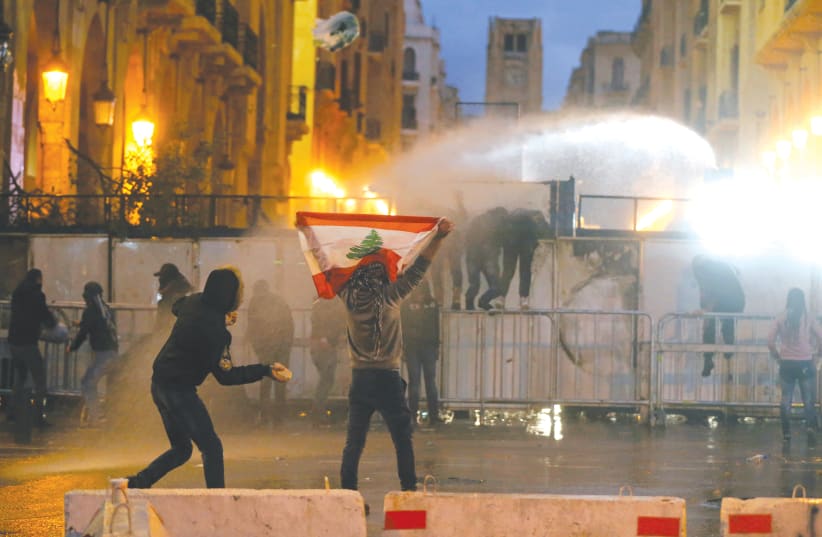Ordinary Lebanese have also been suffering from a suffocating dollar liquidity crisis, one of the factors beyond the October Revolution street protests against sectarian rule, economic stagnation and government corruption that began last fall.
New Prime Minister Hassan Diab, in a televised address to the nation on Saturday, announced that Lebanon would for the first time ever default on a payment, and work to restructure its $92 billion in sovereign debt.
“Lebanon’s debt is greater than the country can handle,” he said.
But Lebanon has additional payments due this month totaling around $700 million, and another $600 million in June, on Eurobonds − sovereign bonds issued in this case in dollars − some of which are held by commercial banks and the central bank.
Marwan Iskandar, chief economic commentator at Beirut’s An-Nahar newspaper, told The Media Line that the liquidity crisis started back in 2008 because of corrupt economic and political decisions that served the interests of the “powers that be” rather than the nation.
“For instance, there is the electric company’s debt that grows by $2 billion annually, even though this could be avoided. But there are powerful interests in Lebanon that benefit from importing oil to generate electricity and they prevent the reform of the electricity sector,” Iskandar explained.
He added that a German company had offered to help improve the electricity sector, under one condition, that it would manage the entire project independently of the government. The latter rejected the proposal outright, “as politics comes first. Lebanon has become ruled by political and sectarian parties, and there’s no party that represents most of the Lebanese. Thus the party interest overcame the national interest, which only makes the crisis worse.”
Iskandar said that in the years after the 2008 global financial crisis, Lebanese who live abroad transferred about $24 billion. to the country, increasing the size of the banks by 30%. “However, in the last two years, about $12 billion has been transferred abroad, not only by Lebanese but also by Arabs of other nationalities, because of a lack of confidence in the banks in Lebanon after they “broke the law to facilitate loans of millions of dollars to unreliable clients.
“Some banks exploited the situation to benefit themselves, not the country,” Iskandar said.
Mahsen Mursel, a Lebanese journalist who specializes in economic affairs, told The Media Line that after the 1975-1990 Lebanese Civil War, the country’s financial system became dependent on the inflow of foreign currencies, based on the idea that if the Lebanese pound’s exchange rate was fixed, it would attract foreign investment. “And it worked, but on the other hand, we missed the chance to create an economy based on agriculture and industry,” she said.
However, Mursel explained that in 2011, after the Syrian civil war began, and after the inflow of foreign currency decreased for economic reasons and for political reasons linked to Hezbollah’s conflicts with other Arab states, Lebanon’s central bank began borrowing from banks at high interest, so it could gradually pump the funds into the market and to maintain the stability of the national currency. “Then the financial system started to collapse; in 2019, Lebanon’s trade deficit reached $18 billion.”
In 2016, she said, the central bank’s reserves fell below the red line. So it resorted to “financial engineering” that incurred high interest payments and increased the government’s debt. “In 2019, they started imposing restrictions on withdrawals [from depositors’ accounts], and that was when the dollar crisis began, and when the poor state of the financial system was completely exposed.”
Mursel said that Lebanon needed to restructure its domestic debt and recapitalize the banks, using large deposits of over a million dollars, given that they made a lot of money because of the high interest throughout the past years.
After the intention to default was announced, Finance Minister Ghazi Wazni said that Lebanon’s foreign exchange reserves totaled more than $20 billion. The central bank of Lebanon announced at the end of February that its foreign currency reserves amounted to $35.8 billion.
The Lebanese state’s debt of $92 billion is the equivalent of about 170% of annual gross domestic product, among the highest ratios in the world.
Protests in Lebanon began in mid-October 2019, triggered by a planned new tax on the use of internet-based communications programs such as WhatsApp, and then widened to express deep dissatisfaction with economic mismanagement, corruption and sectarianism, pushing then-prime minister Sa’ad al-Hariri to resign on October 29, and leading to the formation of the Diab government on January 2.
Ali Amin, a Lebanese analyst and journalist who writes for the London-based, pan-Arab Al-Arab newspaper, told The Media Line the new regime was not a “rescue government,” but rather a “crisis management government” meant to protect the interests of the power centers in the country.
“This is evidenced by the new government’s latest actions, as well as by its ministerial statements. The new government comes as a facade on the same old authorities believed to be the sources of corruption. It’s not an independent government, but rather a group of advisers to the real centers of power,” Amin said.
He said that the new government hadn’t implemented any policy or taken any action to create a “positive shock” so as to merit the country’s trust. “There’s no hope it will save the situation, as any solution would require real political change. The role of the new government is to protect the interest of those who formed it and to manage the crisis,” Amin said.
